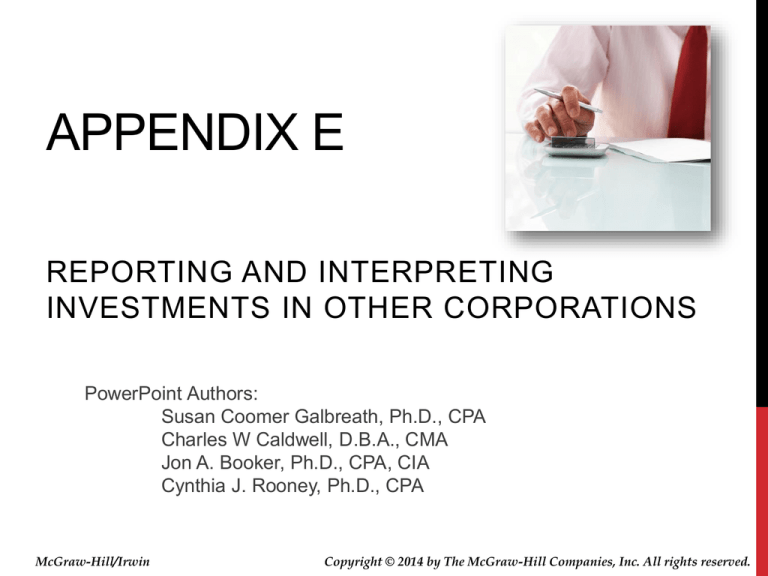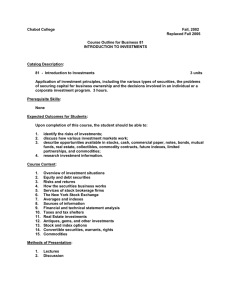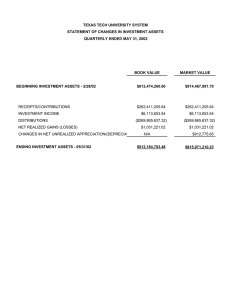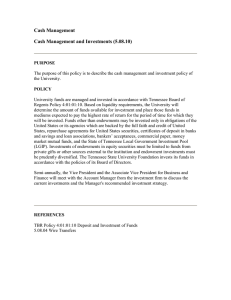
APPENDIX E
REPORTING AND INTERPRETING
INVESTMENTS IN OTHER CORPORATIONS
PowerPoint Authors:
Susan Coomer Galbreath, Ph.D., CPA
Charles W Caldwell, D.B.A., CMA
Jon A. Booker, Ph.D., CPA, CIA
Cynthia J. Rooney, Ph.D., CPA
McGraw-Hill/Irwin
Copyright © 2014 by The McGraw-Hill Companies, Inc. All rights reserved.
UNDERSTANDING THE BUSINESS
A company may invest in the securities
of another company to:
Earn a return
on idle funds.
(passive
investments)
Influence the
other
company’s
policies and
activities.
Control the
other
company.
E-2
PASSIVE INVESTMENTS IN DEBT AND
EQUITY SECURITIES
Passive investments are made to earn a high rate of
return on funds that may be needed for future purposes.
Investments in debt securities are always
considered passive investments.
Equity security investments
are presumed passive if the
investing company owns less
than 20% of the outstanding
voting shares.
The investor is not
interested in controlling
or influencing the other
company.
E-3
INVESTMENTS IN STOCK FOR
SIGNIFICANT INFLUENCE
Investments made with the intent of exerting
significant influence over another corporation.
The ability of the
investing company to
have an important
impact on the
operating and
financial policies of
another company.
Significant
Influence
20% - 50%
outstanding shares
E-4
INVESTMENTS IN STOCK FOR
CONTROL
Investments made with the intent to exert
control over another corporation.
The investing
company has the
ability to determine
the operating and
financial policies of
another corporation.
Control
>50%
outstanding shares
E-5
TYPES OF INVESTMENTS AND
ACCOUNTING METHODS
The accounting method depends
on the type of security and the level
of ownership (influence).
E-6
DEBT HELD TO MATURITY:
AMORTIZED COST METHOD
Record at cost on
acquisition date.
Record interest
received.
Amortize discount
or premium.
Record principal
received at maturity.
E-7
DEBT HELD TO MATURITY:
AMORTIZED COST METHOD
On July 1, 2013, Washington Post paid the par value of
$100,000 for 8 percent bonds that mature on June 30, 2018.
The 8 percent interest is paid on each June 30 and
December 31. Management plans to hold the bonds until
maturity. Prepare the journal entry to record the investment.
E-8
DEBT HELD TO MATURITY:
AMORTIZED COST METHOD
The journal entry to record the receipt of interest on
December 31 of the first year is . . .
E-9
DEBT HELD TO MATURITY:
AMORTIZED COST METHOD
The journal entry to record the receipt of
the principal payment at maturity is . . .
E-10
PASSIVE INVESTMENTS: THE FAIR
VALUE METHOD
Date of
acquisition
Investment is
initially recorded
at cost.
Unrealized
holding gains and
losses are
recorded.
Future
measurement date
Investment carrying
amount is adjusted to
current market value.
Passive investments are reported at fair value
because of relevance and measurability.
E-11
CLASSIFYING PASSIVE
INVESTMENTS AT FAIR VALUE
Type of
Investment
Definition
Actively traded
Trading
for potential
Securities
profit.
Not actively
Available for
traded, held for
Sale
investment
Securities
returns.
Effect of Unrealized Holding Gains and
Losses On . . .
Investment
Account
Equity
Net Income
Reported on
Allowance
N/A
the Income
Account
Statement
Allowance
Account
Reported
as part of
equity
N/A
NOTE: Realized gains and losses go on the Income Statement.
E-12
AVAILABLE FOR SALE (AFS)
SECURITIES
On January 5, 2012, Washington Post acquires 15,000 of the
100,000 outstanding shares of INews on the open market at a
cost of $10 per share. Washington Post has no influence over
INews, and does not plan to sell the shares in the near future.
Should the acquired shares be classified as Trading
Securities or Available for Sale Securities?
Washington Post does not plan to actively trade the shares.
Instead, they will be held to earn a return on invested funds
that may be needed for future operations. The shares
should be classified as Available for Sale Securities.
E-13
AVAILABLE FOR SALE (AFS)
SECURITIES
The journal entry to record
the investment is . . .
The investment may be a current asset
or a noncurrent asset, depending on
management’s intended holding period.
E-14
AVAILABLE FOR SALE (AFS)
SECURITIES
Later in the year, Washington Post
receives a $15,000 dividend from INews.
Prepare the journal entry to record the
dividend.
E-15
AVAILABLE FOR SALE (AFS)
SECURITIES
By December 31, 2012, Washington Post’s fiscal yearend, the market value of INews’ shares has dropped
from $10 to $8 per share. How much has Washington
Post’s portfolio value changed?
Market value ($8 per share × 15,000 shares)
Cost ($10 per share × 15,000 shares)
Unrealized holding loss
$ 120,000
150,000
$ (30,000)
The journal entry to recognize the change in
market value is . . .
E-16
AVAILABLE FOR SALE (AFS)
SECURITIES
The unrealized holding loss is reported in the stockholders’
equity section of Washington Post’s balance
sheet as Other Comprehensive Income.
E-17
AVAILABLE FOR SALE (AFS)
SECURITIES
On December 31, 2013, the market value of INews’
shares is $11 per share, an increase of $3 per share
from December 31, 2012.
December 31, 2013 fair value ($11 per share × 15,000 shares)$ 165,000
December 31, 2012 fair value ($8 per share × 15,000 shares)
120,000
Unrealized holding gain
$
45,000
The journal entry to recognize the change in
market value for 2013 is . . .
E-18
AVAILABLE FOR SALE (AFS)
SECURITIES
Near the end of 2014, Washington Post sells all
15,000 shares of INews for $13 per share.
Proceeds from sale
Cost of INews investment
Gain on sale of INews investment
$ 195,000
150,000
$ 45,000
Net Unrealized Losses/Gains (SE)
Beginning of 2012
$
2012 Unrealized loss
30,000
12/31/12 Balance
$ 30,000
$ 45,000 2013 Unrealized gain
This amount will be
$ 15,000 12/31/13 Balance
removed when the
sale entry is made.
E-19
AVAILABLE FOR SALE (AFS)
SECURITIES
The journal entry to record the 2014 sale of the
INews investment is . . .
$150,000 – $30,000 + $45,000 = $165,000
E-20
COMPARING TRADING AND
AVAILABLE FOR SALE SECURITIES
Effects
Realized Gains
Realized Losses
Unrealized Gains
and Losses
Effects
Unrealized Gains
and Losses
Income Statement
Trading
Securities
Sales Price > Cost
Sales Price < Cost
Adjusted at
Year-end
Balance Sheet
Trading
Securities
N/A
Available for Sale
Securities
Sales Price > Cost
Sales Price < Cost
N/A
Available for Sale
Securities
Adjusted at
Year-end
E-21
KEY RATIO ANALYSIS
Economic Return
from Investing
=
Dividends and Interest Received
+ Change in Fair Value
Fair Value of Investments
(beginning of period)
The economic return from investing ratio measures how
much a company earns for each dollar of investment for
a period. In general, a higher return indicates
management is doing a better job selecting investments.
For the year 2012, Washington Post received $15,000 in
dividends from INews, and the fair value declined from $150,000
at the beginning of the year to $120,000 at the end of the year.
E-22
KEY RATIO ANALYSIS
Economic Return
from Investing
=
Dividends and Interest Received
+ Change in Fair Value
Fair Value of Investments
(beginning of period)
For 2012
Economic Return
from Investing
=
$15,000 – $30,000
$150,000
=
– 10%
E-23
INVESTMENTS FOR SIGNIFICANT
INFLUENCE: EQUITY METHOD
The equity method is used when an investor can
exert significant influence over an investee.
Investment Category
Measuring and
Reporting Method
Stock
Stock
Stock
Fair value
Equity
Consolidated statement
Passive
Significant influence
Control
It is presumed that the investment
was made as a long-term investment.
E-24
INVESTMENTS FOR SIGNIFICANT
INFLUENCE: EQUITY METHOD
Date of
acquisition
Investment is
initially
recorded at
cost.
Unrealized
holding gains and
losses are not
recorded.
Future
measurement date
Investment carrying
amount is adjusted for
dividends received, and
a percentage share of
the investee’s income.
E-25
INVESTMENTS FOR SIGNIFICANT
INFLUENCE: EQUITY METHOD
E-26
RECORDING INVESTMENTS UNDER
THE EQUITY METHOD
At the beginning of 2013, Washington Post
acquires a 40% interest in INews at a cost of
$400,000. Prepare the journal entry to record
Washington Post’s investment.
E-27
EARNINGS OF AFFILIATES
INews net income for 2013 is $500,000.
Washington Post’s 40% share is $200,000. Record
Washington Post’s share of the INews income.
Washington Post credits Equity in Affiliate Earnings (an
income statement account) for its share of INews
earnings.
E-28
DIVIDENDS RECEIVED
During 2013, INews pays $100,000 in dividends,
$40,000 (40%) of which goes to Washington Post.
Record Washington Post’s receipt of the dividend.
Dividends are not revenue under the equity method. They
are treated as a reduction of the investment account.
E-29
INVESTMENTS FOR SIGNIFICANT
INFLUENCE: EQUITY METHOD
E-30
REPORTING INVESTMENTS UNDER
THE EQUITY METHOD
Reported on the balance sheet as a long-term asset,
originally at cost.
Account is increased by the proportional share of affiliate’s income.
Account is decreased by proportional share of affiliate’s losses and
by dividends received from the affiliate.
No adjustment to
fair value at the end
of the accounting
period.
If sold, any
gain or loss is
reported in the
income statement
as other income.
E-31
FOCUS ON CASH FLOWS
E-32
CONTROLLING INTERESTS:
MERGERS AND ACQUISITIONS
Clearing the 20%
hurdle to gain
influence . . .
Vaulting over
the 50% mark
to gain control!
Off and running with
less than 20% . . .
E-33
CONTROLLING INTERESTS:
MERGERS AND ACQUISITIONS
Horizontal
growth
Vertical
integration
Synergy
E-34
WHAT ARE CONSOLIDATED
STATEMENTS?
• The acquiring company is the
parent.
• The company acquired is the
subsidiary.
• Consolidated statements
combine two or more companies
into a single set of statements.
Any transactions
between the
parent and
subsidiary must
be eliminated
when preparing
consolidated
financial
statements.
E-35
RECORDING A MERGER
Goodwill
Occurs when one
company buys
another company.
Only purchased
goodwill is an
intangible asset.
The amount by which the
purchase price exceeds the fair
market value of net assets acquired.
E-36
RECORDING A MERGER
Washington Post paid $1,000,000 in cash to purchase all
the stock of INews. Washington Post merged INews’
operations into its own operations, and INews ceased to
exist as a separate entity. The following information is
available at the date of acquisition:
Fair value of equipment
Fair value of patents
Total fair value of assets
INews note payable
Fair value of net assets
$
$
350,000
600,000
950,000
100,000
850,000
Should Washington Post record goodwill?
E-37
RECORDING A MERGER
Purchase price for INews
Fair value of net assets acquired
Purchased goodwill
$
$
1,000,000
850,000
150,000
The journal entry to record the
acquisition of INews is . . .
E-38
RECORDING A MERGER
Goodwill
Not amortized.
Subject to assessment
for impairment of
value and may be
written down.
E-39
REPORTING FOR COMBINED
COMPANIES
The acquired company is
merged into acquiring
company.
The acquired and acquiring
companies continue separate
legal existences.
The acquiring company will
treat the acquired assets and
liabilities in the same manner
as if they had been acquired
individually
Consolidated financial
statements are prepared which
look the same as if the
companies had been combined
into one in a merger.
E-40
END OF APPENDIX E
E-41








